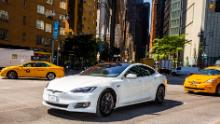Tesla’s new Model S can get 400 miles on a charge. Here’s why that may not matter
But that milestone may not actually mean that much to consumers.
A number of electric vehicles already on the market get more than 200 miles of range, which many experts feel is enough to give car shoppers sufficient comfort.
“For an EV, anything over 200 miles is going to be more than enough for almost everybody,” said Sam Abuelsamid, an EV industry analyst with the consulting firm Guidehouse Insights.
And for those car shoppers that still aren’t comfortable, even with a driving range of more than 200 miles, the jump to 400 isn’t going to help, said Jessica Caldwell, an analyst with Edmunds.com.
“That difference between 100 to 200 is great, but 300 to 400 maybe is less impactful,” she said.
More (and better) chargers
For those customers who are still hesitant, their issue isn’t really range anymore, she said. It’s charging infrastructure.
“[The chargers] have to be working, not broken” she said, “And not like the line is super long line to get to.”
More chargers are being installed. The number of publicly accessible chargers increased 60% around the world between 2018 and 2019, according to the International Energy Agency. The bulk of that growth was in China, however.
Is it worth the cost?
In terms of price, the Tesla Model S Long Range Plus is in the upper echelons, even among luxury vehicles. The base price of the Tesla Model S Long Range Plus is around $75,000, roughly the same as the Long Range model it replaces, which had an EPA-rated 373 miles of range.
It’s difficult to get a sense of how much money that translates to in terms of dollars-per-mile since the only other version of the Model S currently offered on Tesla’s web site in the US is the Model S Performance, which costs almost $90,000. The Model S Performance can go just 348 miles on a charge, but buyers are presumably paying for the car’s 2.3 second zero-to-60 time and better handling. (The Long Range Plus goes from zero to 60 in a comparatively leisurely 3.7 seconds.)
More long-range EVs on the way
Another thing to consider is that Tesla won’t be the only auto maker that will offer electric vehicles that can go hundreds of miles on a chrarge.
EPA estimates, mind you, are just estimates. Driving ranges for EVs are measured using the same tests the EPA dictates for gasoline-powered vehicles. These are designed to mimic actual usage but they are highly standardized laboratory tests which means that, as the expression goes, “Your mileage may vary.”
With an EPA estimate of 402 miles, Tesla Model S Long Range Plus drivers should be able to easily exceed 300 miles of range in their daily driving, though, said Abuelsamid.
In testing by Consumer Reports, Tesla vehicles did come close to the EPA range estimates, said Jake Fisher, the group’s head of auto testing. And, he said, every little bit helps.
“It’s one of these things like you could never be too wealthy or too thin, right?” said Fisher. “You can never have too much range on an electric car.”


